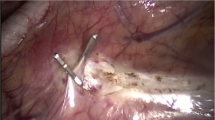Abstract
Background
Compensatory hyperhidrosis is the most troublesome side effect and the leading cause of regret with sympathetic surgery. A new classification is proposed to make the procedure more selective and to minimize the side effects and regret rate. Also, a proposed mechanism for compensatory hyperhidrosis is discussed.
Methods
Between January 2002 and July 2003, 464 patients with various sympathetic disorders underwent thoracoscopic sympathectomy/sympathicotomy (ETS) or sympathetic block by clipping (ESB) at various levels according to the authors’ classification. The surgery was performed on an outpatient basis. The rates of success, compensatory hyperhidrosis, and regret were recorded.
Results
All the patients were followed up for 17 to 35 months. All excessive sweating was effectively stopped to varying degrees. The 25 patients with palmar hyperhidrosis who insisted on receiving ETS of T4 experienced no compensatory hyperhidrosis. Of the 54 patients with facial blushing who received ESB of T2, 23 experienced compensatory hyperhidrosis. Nine patients expressed regret and requested removal of the clips. Of the 33 patients with craniofacial hyperhidrosis who received ESB of T3, 9 experienced compensatory hyperhidrosis. Three expressed regret, and reverse procedures were performed. For 324 patients with palmar hyperhidrosis receiving ESB of T4, no compensatory hyperhidrosis was found. Only two expressed regret because of discomfort. No compensatory hyperhidrosis or regret was noted with 28 patients who received ESB of T5 for axillary sweating. There was no recurrence in the entire series.
Conclusions
Different procedures are recommended for different sympathetic disorders according to the classification. The higher the level of sympathetic ganglion blockade, the higher is the regret rate. Therefore, for T2 and T3 ganglion, endoscopic thoracic sympathetic block by the clipping method is strongly recommended because of its reversibility.




Similar content being viewed by others
References
Atkins HJB (1954) Sympathectomy by the axillary approach. Lancet 1: 538–539
Choi BC, Lee YC, Sim SB (2003) Treatment of palmar hyperhidrosis by endoscopic clipping of the upper part of the T4 sympathetic ganglion. Clin Auton Res 13(Suppl 1): 48–51
Chou SH, Lee SH, Kao EL (1993) Thoracic endoscopic T2–T3 sympathectomy in palmar hyperhidrosis: experience of 112 cases. Jpn J Surg 23: 105–107
Cloward RB (1957) Treatment of hyperhidrosis palmaris (sweating hands): a familial disease in Japanese. Hawaii Med J 16: 381–387
Colon KC, Keaveny TV (1987) Upper dorsal sympathectomy for palmar hyperhidrosis. Br J Surg 74: 651
Kao MC (1992) Laser endoscopic sympathectomy using a fiberoptic CO2 laser to treat palmar hyperhidrosis. Neurosurgery 30: 131–135
Kao MC, Lin JY, Chen YL, Hsieh CS, Cheng LCJ, Huang SJ (1996) Minimally invasive surgery: video endoscopic thoracic sympathectomy for palmar hyperhidrosis. Ann Academy Med 25: 673–678
Keller SM, Lin CC (2005) Surgical treatment of hyperhidrosis. In: Sellke FW, del Nido PJ, Swanson SJ (eds) Sabiston and Spencer: surgery of the chest. 7th ed. Philadephia, WB Saunders, pp 703–709
Lin CC (1990) A new method of thoracoscopic sympathectomy in hyperhidrosis palmaris. Surg Endosc 4: 224–226
Lin CC (1992) Extended thoracoscopic T2 sympathectomy in treatment of hyperhidrosis: experience with 130 consecutive cases. J Laparoendoscopic surg 2: 1–6
Lin CC, Mo LR, Lee LS, Ng SM, Hwang MH (1998) Thoracoscopic T2 sympathectomy block by clipping: a better and reversible operation for treatment of hyperhidrosis palmaris: experience with 326 cases. Eur J Surg 580: 13–16
Lin CC, Telaranta T (2001) Lin-Telaranta classification: the importance of different procedures for different indications in sympathetic surgery. Ann Chir Gynaecol 90: 161–166
Lin CC, Wu HH (2001) Endoscopic T4 sympathetic block by clamping (ESB4) in treatment of hyperhidrosis palmaris et axillaries: experiences of 165 cases. Ann Chir Gynaecol 90: 167–169
Linder F, Jenal G, Assmus H (1983) Axillary transpleural sympathectomy: indication, technique, and results. World J Surg 7: 437–439
Loewy AD, Spyer KM (1990) Central regulation of autonomic functions. Oxford University Press, New York, pp 88–103
Nauson EM (1957) The anterior approach to upper dorsal sympathectomy. Surg Gynecol Obstet 104: 118–120
Neumayer C, Zacherl J, Holak G, Fugger R, Jakesz R, Herbst F, Bischof G (2004) Limited endoscopic thoracic sympathetic block of hyperhidrosis of the upper limb: reduction of compensatory sweating by clipping T4. Surg Endosc 18: 152–156
Ogawa T (1975) Thermal influence on palmar sweating and mental influence on generalized sweating in man. Jpn J Physiol 25: 525–536
Ray BS, Hinsey JC, Geohegan WA (1943) Observation on the distribution of the sympathetic nerves to the pupil and upper extremity as determined by stimulation of the anterior roots in man. Ann Surg 118: 647–655
Riet M, Smet AAEA, Kuiken H, Kazemier G, Bonjer HJ (2001) Prevention of compensatory hyperhidrosis after thoracoscopic sympathectomy for hyperhidrosis. Surg Endosc 15: 1159–1162
Vetrugno R, Liguori R, Cortelli P, Montagna P (2003) Sympathetic skin response: basic mechanisms and clinical applications. Clin Auton Res 13: 256–270
White JC, Smithwick RH, Allen AW (1933) A new muscle-splitting incision for resection for the upper thoracic sympathetic ganglia. Surg Gynecol Obstet 56: 651–657
Williams PL, Warwick R, Dyson M, Bannister LH (2000) The sympathetic nervous system: Gray’s anatomy. Churchill Livingstone, Edinburgh pp 1157–1169
Author information
Authors and Affiliations
Corresponding author
Rights and permissions
About this article
Cite this article
Chou, SH., Kao, EL., Lin, CC. et al. The importance of classification in sympathetic surgery and a proposed mechanism for compensatory hyperhidrosis: experience with 464 cases. Surg Endosc 20, 1749–1753 (2006). https://doi.org/10.1007/s00464-005-0829-7
Received:
Accepted:
Published:
Issue Date:
DOI: https://doi.org/10.1007/s00464-005-0829-7




